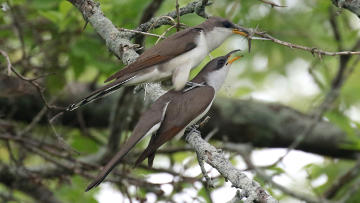

PHOTO COURTESY OF GARRY KESSLER
A pair of yellow-billed cuckoos. The male is presenting a dragonfly to the female as part of their courtship
June 23, 2017, Page A5
NATURE NOTES
By Annie Reid
Westborough Community Land Trust
A year for cuckoos
Look who’s come to dine – yellow-billed cuckoos. They’re real birds, not carvings on European cuckoo clocks. And they’re here, probably in greater numbers than usual, most likely thanks to past outbreaks of gypsy moth caterpillars.
Yellow-billed cuckoos (Coccyzus americanus), as well as black-billed cuckoos (Coccyzus erythropthalmus), specialize in eating large, hairy caterpillars. They typically go for hairy tent caterpillars, which emerge from webs found in the spring on fruit trees, such as apple trees and wild cherry trees, including black cherry (Prunus serotina) and especially choke cherry (Prunus virginiana). The good news for us is that cuckoos also go after gypsy moth caterpillars, such as those we saw way too often last year. A yellow-billed cuckoo can eat 40 large caterpillars in just 15 minutes. Both yellow-billed and black-billed cuckoos are back this year, undoubtedly in search of another abundant food supply. (Many birds eat caterpillars but take small, smooth ones.)
How do cuckoos deal with hairy caterpillars? The hairs collect in their stomach and then get regurgitated in a pellet.
What kind of feast will the cuckoos have this year? So far, predictions suggest that they may be disappointed by the gypsy moth caterpillars. The rains we’ve had this spring are not only alleviating the drought that struck last year, but have also been good for the insect-killing fungus that infects gypsy moth caterpillars, killing them at an early stage. Experts say we’re unlikely to get a big gypsy moth outbreak this year.
Fortunately, cuckoos also eat tent caterpillars and other large insects, such as the dragonfly that the male in our photo is presenting to the female as part of their courtship. Grasshoppers, cicadas, and crickets are also fair game.
Cuckcoos have a streamlined look – long and slender at 10-11 inches long (about the size of a blue jay, but slim and secretive). They’re dark on top and dull white underneath. Their downward-curving bills are yellow-orange on the lower bill in yellow-billed cuckoos and gray-black in black-billed cuckoos. You might also glimpse large white spots on the underside of a cuckoo’s long tail when the bird flies or perches on a branch. Cuckoos hang out near water in leafy treetops in wooded areas with clearings, in such places as the Westborough Wildlife Management Area.
If you listen for a cuckoo, don’t expect the two-note “cuck-coo” of a cartoon cuckoo clock. Listen instead for a repeated hollow knocking sound (https://www.allaboutbirds.org/guide/Yellow-billed_Cuckoo/sounds). If you’ve heard what you thought was a distant squirrel or chipmunk scolding with a clucking or chipping sound, you might actually have heard a cuckoo. These birds also coo, but it’s a much quieter sound.
Cuckoos are reputed to lay eggs in other birds’ nests, but this behavior is more typical of European cuckoos than our North American ones. Yellow-billed and black-billed cuckoos sometimes do this, perhaps in robin or catbird nests, but they more commonly make their own nests and raise their own chicks. Young cuckoos grow very fast and often leave the nest about a week after hatching, when they’re only half the size of adults and can’t yet fly. The adults continue to feed them.
Our cuckoos migrate to South America for the winter. Their populations have declined by half since the 1960s, especially in the western U.S., as development has turned their habitat into farmland and housing developments.
Take advantage of this good year for cuckoos by looking and listening for them in our area this month and next.